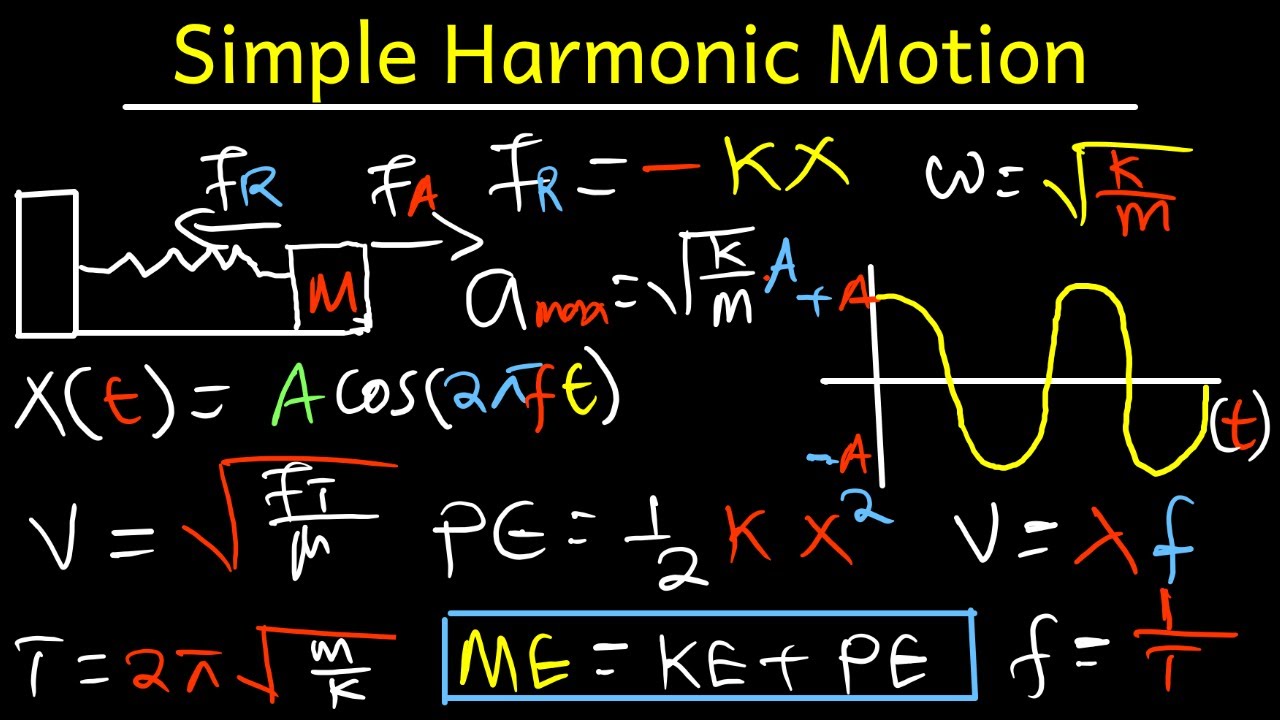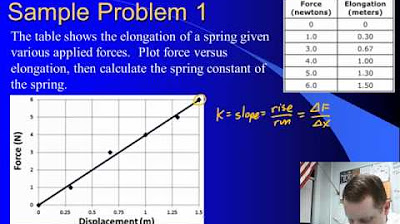Elastic Potential Energy - IB Physics
TLDRThis video script delves into the concept of elastic potential energy, focusing on the properties of springs. It introduces key variables like displacement (ΔX) and spring force (FS), and explains the spring constant (K) as a measure of force applied per unit stretch. Hooke's Law is highlighted, illustrating the linear relationship between force and displacement. The script further explores the equation for elastic potential energy, demonstrating its calculation through a force-displacement graph, and concludes with examples to solidify understanding.
Takeaways
- 🌟 Elastic potential energy is related to springs and their properties.
- 🔍 Delta X represents the displacement of a spring from its natural length.
- 🤔 FS is the spring force applied by a spring on an object, always pointing towards the spring's natural length.
- 🏠 The natural length of a spring is where it rests without any external force.
- 🔄 Displacement of a spring results in a force that pushes back in the opposite direction.
- 🔢 The spring constant (K) measures the force applied by a spring per meter of stretch or compression.
- 📚 Hooke's Law states that the force from a spring is equal to the negative spring constant times Delta X.
- 📈 The force-displacement graph of a spring is a straight line with a slope of K and a y-intercept of zero.
- 🔋 Elastic potential energy is the energy stored in a spring when it is stretched or compressed from its natural length.
- 📉 The equation for elastic potential energy is \( \frac{1}{2} \times K \times \Delta X^2 \), where K is the spring constant and Delta X is the displacement.
Q & A
What is elastic potential energy?
-Elastic potential energy is the energy stored in a spring when it is stretched or compressed from its natural length. It has the potential to do work as the spring returns to its natural length.
What are the two variables introduced in the script related to springs?
-The two variables introduced are Delta X, which represents the displacement of a spring from its natural length, and FS, which is the force applied by a spring on an object, also known as the spring force.
Why does the spring force always point towards the spring's natural length position?
-The spring force always points towards the spring's natural length position because it is a restoring force that acts to return the spring to its equilibrium state when it is stretched or compressed.
What is the spring constant (K) and how is it measured?
-The spring constant (K) is a measure of the force that a spring applies per meter of its stretch or compression. It is calculated using the formula K = force / Delta X, and its units are Newtons per meter.
What is Hooke's law and how does it relate to the spring force?
-Hooke's law states that the force exerted by a spring is equal to the negative spring constant (K) times the displacement (Delta X). It helps in understanding that the force exerted by a spring is proportional to its displacement and always acts in the opposite direction.
How is the force from a spring calculated using Hooke's law?
-The force from a spring is calculated using Hooke's law as force = -K * Delta X. The negative sign indicates that the force is in the opposite direction of the displacement.
What is the equation for elastic potential energy in terms of the spring constant and displacement?
-The equation for elastic potential energy is given by EP = 1/2 * K * (Delta X)^2, where EP is the elastic potential energy, K is the spring constant, and Delta X is the displacement from the spring's natural length.
How is the work done by a spring related to the area under the force-displacement graph?
-The work done by a spring is equal to the area under the force-displacement graph because work is the product of force and displacement, and the area under the curve represents this product over the range of displacements.
Why is the force-displacement graph for a spring a straight line with a slope of K?
-The force-displacement graph for a spring is a straight line with a slope of K because the relationship between force and displacement is linear, as described by Hooke's law, where force is directly proportional to displacement with K as the constant of proportionality.
Can you provide an example of calculating the work required to stretch a spring from one length to another?
-Yes, for example, if a spring with a spring constant (K) of 200 N/m is initially stretched by 3 meters and then stretched further to 5 meters, the work required is the change in elastic potential energy, which is the final potential energy (2500 J) minus the initial potential energy (900 J), resulting in 1600 J of work done on the spring.
Outlines
😲 Understanding Elastic Potential Energy and Springs
This paragraph introduces the concept of elastic potential energy, specifically in relation to springs. It explains the importance of a spring's natural length and how displacement from this position results in a force, described by the spring force variable 'FS'. The spring constant 'k' is introduced as a measure of the force applied per meter of stretch, with Hooke's Law formulating the relationship between force, displacement, and the spring constant. An example is provided to demonstrate the calculation of force using Hooke's Law, emphasizing the negative sign indicating the opposing direction of force relative to displacement.
📚 Calculating Elastic Potential Energy with Hooke's Law
The paragraph delves into the calculation of elastic potential energy stored in a spring when it is stretched or compressed. It clarifies that the force exerted by the spring changes with displacement, making it unsuitable for direct work calculation using the formula 'work = force x displacement'. Instead, the concept of a force-displacement graph is introduced to determine the work done by the spring. The area under the graph represents the work, and since the relationship is linear, the area is calculated as a triangle's area, leading to the elastic potential energy formula: 1/2 * k * Δx^2. An example calculation is provided to illustrate the process.
🔍 Applying Elastic Potential Energy Formula to Practical Examples
This paragraph applies the concept of elastic potential energy to practical scenarios, showing how to calculate the energy stored in a spring and the work required to change its stretch. It demonstrates the calculation of initial and final potential energies for a spring with given constants and stretches, highlighting the significant impact of the square of the stretch on energy values. The work done on the spring is equated to the change in energy, providing a clear method for determining the energy and work involved in stretching a spring to a new position.
Mindmap
Keywords
💡Elastic Potential Energy
💡Spring Constant (k)
💡Displacement (Δx)
💡Hooke's Law
💡Spring Force (FS)
💡Natural Length
💡Work-Energy Principle
💡Force-Displacement Graph
💡Joules
💡Linear Relationship
💡Area Under the Curve
Highlights
Introduction to elastic and potential energy with a focus on springs and their properties.
Definition of ΔX as the displacement of a spring from its natural length.
Introduction of FS as the spring force applied on an object.
Explanation of spring force direction towards the spring's natural length position.
Illustration of natural length as the resting state of a spring without external force.
Concept of spring force being experienced only when the spring is stretched or compressed.
Introduction of lowercase K as the spring constant, measuring force per meter of stretch.
Equation for spring constant, K = force / ΔX, with units in Newtons per meter.
Hooke's Law formula: Force = -K * ΔX, explaining the negative sign and force direction.
Example calculation using Hooke's Law for a stretched spring.
Introduction to elastic potential energy as the energy stored in a spring.
Elastic potential energy's potential to do work upon release of the spring.
Explanation of the variable 'ep' for elastic potential energy and its unit, joules.
Complexity of calculating work done by a spring due to varying force during displacement.
Use of force-displacement graph to determine work done and elastic potential energy.
Derivation of the elastic potential energy equation: EP = 1/2 * K * ΔX^2.
Application of the elastic potential energy equation in solving practical problems.
Calculation of work required to stretch a spring from one length to another.
Emphasis on the significance of the squared term in the elastic potential energy equation.
Transcripts
Browse More Related Video

Hooke's Law and Elastic Potential Energy

(previous version) Introduction to Elastic Potential Energy with Examples

Potential energy stored in a spring | Work and energy | Physics | Khan Academy

Simple Harmonic Motion, Mass Spring System - Physics Full Topic

AP Physics C: Work, Energy, and Power Review (Mechanics)

High School Physics - Springs and Hooke's Law
5.0 / 5 (0 votes)
Thanks for rating: